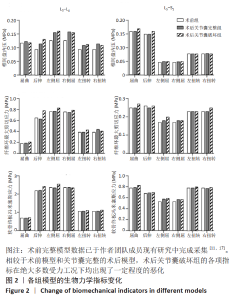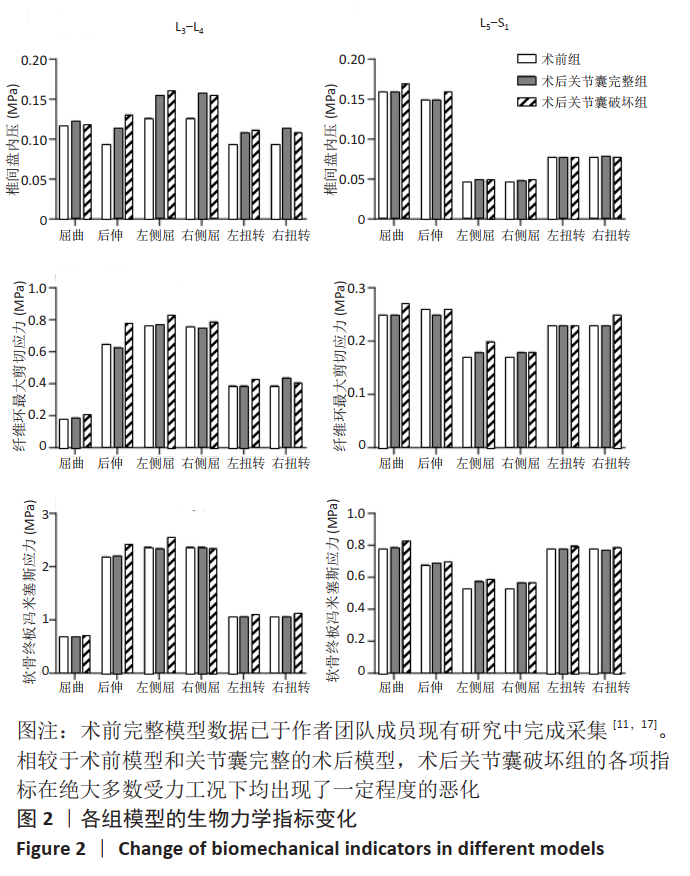[1] PARK P, GARTON HJ, GALA VC, et al. Adjacent segment disease after lumbar or lumbosacral fusion: review of the literature. Spine (Phila Pa 1976). 2004;29(17):1938-1944.
[2] WANG H, MA L, YANG D, et al. Incidence and risk factors of adjacent segment disease following posterior decompression and instrumented fusion for degenerative lumbar disorders. Medicine (Baltimore). 2017; 96(5):e6032.
[3] LIANG J, DONG Y, ZHAO H. Risk factors for predicting symptomatic adjacent segment degeneration requiring surgery in patients after posterior lumbar fusion. J Orthop Surg Res. 2014;9:97.
[4] ADAMS MA, ROUGHLEY PJ. What is intervertebral disc degeneration, and what causes it? Spine (Phila Pa 1976). 2006;31(18):2151-2161.
[5] ADAMS MA, FREEMAN BJ, MORRISON HP, et al. Mechanical initiation of intervertebral disc degeneration. Spine (Phila Pa 1976). 2000;25(13): 1625-1636.
[6] ADAMS MA, DOLAN P. Intervertebral disc degeneration: evidence for two distinct phenotypes. J Anat. 2012;221(6):497-506.
[7] DOLAN P, LUO J, POLLINTINE P, et al. Intervertebral disc decompression following endplate damage: implications for disc degeneration depend on spinal level and age. Spine (Phila Pa 1976). 2013;38(17):1473-1481.
[8] PAN M, LI Q, LI S, et al. Percutaneous Endoscopic Lumbar Discectomy: Indications and Complications. Pain Physician. 2020;23(1):49-56.
[9] RUETTEN S, KOMP M. Endoscopic Lumbar Decompression.Neurosurg Clin N Am. 2020;31(1):25-32.
[10] BERMEL EA, BAROCAS VH, ELLINGSON AM. The role of the facet capsular ligament in providing spinal stability. Comput Methods Biomech Biomed Engin. 2018;21(13):712-721.
[11] LI J, XU W, JIANG Q, et al. Indications Selection for Surgeons Training in the Translaminar Percutaneous Endoscopic Discectomy Based on Finite Element Analysis. Biomed Res Int. 2020;2020:2960642.
[12] MOCHIDA J, NISHIMURA K, NOMURA T, et al. The importance of preserving disc structure in surgical approaches to lumbar disc herniation. Spine (Phila Pa 1976). 1996;21(13):1556-1563;discussion 1563-1554.
[13] SCHALLER B. Failed back surgery syndrome: the role of symptomatic segmental single-level instability after lumbar microdiscectomy. Eur Spine J. 2004;13(3):193-198.
[14] KIM HJ, KANG KT, CHUN HJ, et al. The influence of intrinsic disc degeneration of the adjacent segments on its stress distribution after one-level lumbar fusion. Eur Spine J. 2015;24(4):827-837.
[15] KIM HJ, KANG KT, SON J, et al. The influence of facet joint orientation and tropism on the stress at the adjacent segment after lumbar fusion surgery: a biomechanical analysis. Spine J. 2015;15(8):1841-1847.
[16] HSIEH YY, CHEN CH, TSUANG FY, et al. Removal of fixation construct could mitigate adjacent segment stress after lumbosacral fusion: A finite element analysis. Clin Biomech (Bristol, Avon). 2017;43:115-120.
[17] LI J, ZHANG X, XU W, et al. Reducing the extent of facetectomy may decrease morbidity in failed back surgery syndrome. BMC Musculoskelet Disord. 2019;20(1):369.
[18] TANG S, REBHOLZ BJ. Does lumbar microdiscectomy affect adjacent segmental disc degeneration? A finite element study. J Surg Res. 2013; 182(1):62-67.
[19] DREISCHARF M, ZANDER T, SHIRAZI-ADL A, et al. Comparison of eight published static finite element models of the intact lumbar spine: predictive power of models improves when combined together. J Biomech. 2014;47(8):1757-1766.
[20] CHUANG WH, KUO YJ, LIN SC, et al. Comparison among load-, ROM-, and displacement-controlled methods used in the lumbosacral nonlinear finite-element analysis. Spine (Phila Pa 1976). 2013;38(5):E276-285.
[21] CHUANG WH, LIN SC, CHEN SH, et al. Biomechanical effects of disc degeneration and hybrid fixation on the transition and adjacent lumbar segments: trade-off between junctional problem, motion preservation, and load protection. Spine (Phila Pa 1976). 2012;37(24):E1488-1497.
[22] LI J, XU W, ZHANG X, et al. Biomechanical role of osteoporosis affects the incidence of adjacent segment disease after percutaneous transforaminal endoscopic discectomy. J Orthop Surg Res. 2019; 14(1):131.
[23] DU CF, YANG N, GUO JC, et al. Biomechanical response of lumbar facet joints under follower preload: a finite element study. BMC Musculoskelet Disord. 2016;17:126.
[24] SCHMIDT H, GALBUSERA F, ROHLMANN A, et al. Effect of multilevel lumbar disc arthroplasty on spine kinematics and facet joint loads in flexion and extension: a finite element analysis. Eur Spine J. 2012;21 Suppl 5(Suppl 5):S663-674.
[25] ZHANG C, SHI J, CHANG M, et al. Does Osteoporosis Affect the Adjacent Segments Following Anterior Lumbar Interbody Fusion? A Finite Element Study. World Neurosurg. 2021;146:e739-e746.
[26] PEZOWICZ CA, SCHECHTMAN H, ROBERTSON PA, et al. Mechanisms of anular failure resulting from excessive intradiscal pressure: a microstructural-micromechanical investigation. Spine (Phila Pa 1976). 2006;31(25):2891-2903.
[27] TSOUKNIDAS A, SARIGIANNIDIS SO, ANAGNOSTIDIS K, et al. Assessment of stress patterns on a spinal motion segment in healthy versus osteoporotic bony models with or without disc degeneration: a finite element analysis. Spine J. 2015;15(3 Suppl):S17-s22.
[28] QASIM M, NATARAJAN RN, AN HS, et al. Damage accumulation location under cyclic loading in the lumbar disc shifts from inner annulus lamellae to peripheral annulus with increasing disc degeneration. J Biomech. 2014;47(1):24-31.
[29] SCHMIDT H, HEUER F, SIMON U, et al. Application of a new calibration method for a three-dimensional finite element model of a human lumbar annulus fibrosus. Clin Biomech (Bristol, Avon). 2006;21(4): 337-344.
[30] HEUER F, SCHMIDT H, CLAES L, et al. Stepwise reduction of functional spinal structures increase vertebral translation and intradiscal pressure. J Biomech. 2007;40(4):795-803.
[31] HEUER F, SCHMIDT H, KLEZL Z, et al. Stepwise reduction of functional spinal structures increase range of motion and change lordosis angle. J Biomech. 2007;40(2):271-280.
[32] SCHMIDT H, HEUER F, DRUMM J, et al. Application of a calibration method provides more realistic results for a finite element model of a lumbar spinal segment. Clin Biomech (Bristol, Avon). 2007;22(4): 377-384.
[33] SCHMIDT H, GALBUSERA F, ROHLMANN A, et al. What have we learned from finite element model studies of lumbar intervertebral discs in the past four decades? J Biomech. 2013;46(14):2342-2355.
[34] TZERMIADIANOS MN, MEKHAIL A, VORONOV LI, et al. Enhancing the stability of anterior lumbar interbody fusion: a biomechanical comparison of anterior plate versus posterior transpedicular instrumentation. Spine (Phila Pa 1976). 2008;33(2):E38-43.
[35] LAWS CJ, COUGHLIN DG, LOTZ JC, et al. Direct lateral approach to lumbar fusion is a biomechanically equivalent alternative to the anterior approach: an in vitro study. Spine (Phila Pa 1976). 2012;37(10): 819-825.
[36] NEWELL N, LITTLE JP, CHRISTOU A, et al. Biomechanics of the human intervertebral disc: A review of testing techniques and results. J Mech Behav Biomed Mater. 2017;69:420-434.
[37] DELUCCA JF, CORTES DH, JACOBS NT, et al. Human cartilage endplate permeability varies with degeneration and intervertebral disc site. J Biomech. 2016;49(4):550-557.
[38] LI Z, LIU H, YANG H, et al. Both expression of cytokines and posterior annulus fibrosus rupture are essential for pain behavior changes induced by degenerative intervertebral disc: An experimental study in rats. J Orthop Res. 2014;32(2):262-272.
[39] ZHOU C, CHA T, LI G. An upper bound computational model for investigation of fusion effects on adjacent segment biomechanics of the lumbar spine. Comput Methods Biomech Biomed Engin. 2019; 22(14):1126-1134. |

